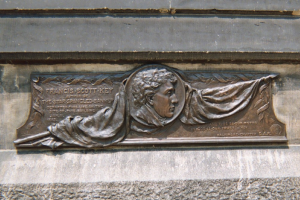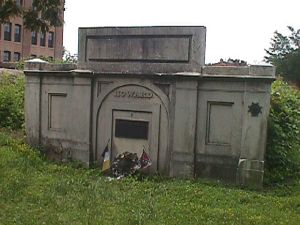Difference between revisions of "Francis Scott Key" - New World Encyclopedia
m (Robot: Remove date links) |
m (Robot: Remove date links) |
||
| Line 3: | Line 3: | ||
[[Image:ft_mchenry_cannon.750.jpg|thumb|right|[[Fort McHenry]] looking towards the position of the British ships (with the [[Francis Scott Key Bridge (Baltimore)|Francis Scott Key Bridge]] in the distance on the upper left)]] | [[Image:ft_mchenry_cannon.750.jpg|thumb|right|[[Fort McHenry]] looking towards the position of the British ships (with the [[Francis Scott Key Bridge (Baltimore)|Francis Scott Key Bridge]] in the distance on the upper left)]] | ||
| − | '''Francis Scott Key''' (August 1, | + | '''Francis Scott Key''' (August 1, 1779 – January 11, 1843) was an [[United States|American]] [[lawyer]] and amateur [[poet]] who wrote the words to the United States [[national anthem]], "[[The Star-Spangled Banner]]". |
==Life== | ==Life== | ||
| Line 9: | Line 9: | ||
He was born to Ann Louis Penn Dagworthy (Charlton) and Capt [[John Ross Key]] at the family plantation Terra Rubra near [[Frederick, Maryland]]. He was an alumnus of [[St. John's College, U.S.|St. John's College]], [[Annapolis, Maryland]]. | He was born to Ann Louis Penn Dagworthy (Charlton) and Capt [[John Ross Key]] at the family plantation Terra Rubra near [[Frederick, Maryland]]. He was an alumnus of [[St. John's College, U.S.|St. John's College]], [[Annapolis, Maryland]]. | ||
| − | During the [[War of 1812]], Key, accompanied by the American Prisoner Exchange Agent Col. John Stuart Skinner, dined aboard the British ship [[HMS Tonnant (1792)|HMS ''Tonnant'']], as the guests of Vice Adm. [[Alexander Cochrane]], RAdm. Sir [[George Cockburn]] and Major General [[Robert Ross]]. They were there to negotiate the release of a prisoner, Dr. William Beanes. A resident of [[Upper Marlboro, Maryland]], Beanes had been captured by the British after he placed rowdy stragglers under citizen's arrest. Skinner, Key and Beanes were allowed to return to their own sloop, but were not allowed to return to Baltimore because they had become familiar with the strength and position of the British units and of the British intention to attack Baltimore. As a result of this, Key was unable to do anything but watch the bombarding of Ft. McHenry during the [[Battle of Baltimore]], and was inspired to write a poem describing the experience. Entitled <!-- the spelling defence is used in the original —>"The Defence of Fort McHenry", intended to fit the rhythms of [[composer]] [[John Stafford Smith]]'s "[[To Anacreon in Heaven]]", it has become better known as "The [[Star Spangled Banner]]". Under this name, the song was adopted as the American national anthem by a Congressional resolution in | + | During the [[War of 1812]], Key, accompanied by the American Prisoner Exchange Agent Col. John Stuart Skinner, dined aboard the British ship [[HMS Tonnant (1792)|HMS ''Tonnant'']], as the guests of Vice Adm. [[Alexander Cochrane]], RAdm. Sir [[George Cockburn]] and Major General [[Robert Ross]]. They were there to negotiate the release of a prisoner, Dr. William Beanes. A resident of [[Upper Marlboro, Maryland]], Beanes had been captured by the British after he placed rowdy stragglers under citizen's arrest. Skinner, Key and Beanes were allowed to return to their own sloop, but were not allowed to return to Baltimore because they had become familiar with the strength and position of the British units and of the British intention to attack Baltimore. As a result of this, Key was unable to do anything but watch the bombarding of Ft. McHenry during the [[Battle of Baltimore]], and was inspired to write a poem describing the experience. Entitled <!-- the spelling defence is used in the original —>"The Defence of Fort McHenry", intended to fit the rhythms of [[composer]] [[John Stafford Smith]]'s "[[To Anacreon in Heaven]]", it has become better known as "The [[Star Spangled Banner]]". Under this name, the song was adopted as the American national anthem by a Congressional resolution in 1931, signed by President [[Herbert Hoover]]. |
A note in the Maritime Museum at World Trade Centre, Cuffe Parade, Mumbai, India states the "Seventy-four gun ship 'MINDEN', (built by the famous Wadia family) launched in 1810, became famous when FRANCIS SCOTT KEY briefly improvised onboard in Baltimore, wrote the 'Star Sangled Banner', later to become the American National Anthem". Probably "briefly improvised onboard" was meant to be "imprisoned." | A note in the Maritime Museum at World Trade Centre, Cuffe Parade, Mumbai, India states the "Seventy-four gun ship 'MINDEN', (built by the famous Wadia family) launched in 1810, became famous when FRANCIS SCOTT KEY briefly improvised onboard in Baltimore, wrote the 'Star Sangled Banner', later to become the American National Anthem". Probably "briefly improvised onboard" was meant to be "imprisoned." | ||
| Line 26: | Line 26: | ||
His sister, Anne Phoebe Charlton Key, married [[Roger B. Taney]], future [[Chief Justice of the United States]] and author of the Court's [[Dred Scott v. Sandford|Dred Scott decision]]. | His sister, Anne Phoebe Charlton Key, married [[Roger B. Taney]], future [[Chief Justice of the United States]] and author of the Court's [[Dred Scott v. Sandford|Dred Scott decision]]. | ||
| − | Francis Scott Key was inducted into the [[Songwriters' Hall of Fame]] in | + | Francis Scott Key was inducted into the [[Songwriters' Hall of Fame]] in 1970. |
[[Robert Altman]] credited him with the "title song" of ''[[Brewster McCloud]]'', though it contained only [[John Stafford Smith]]'s instrumentals. | [[Robert Altman]] credited him with the "title song" of ''[[Brewster McCloud]]'', though it contained only [[John Stafford Smith]]'s instrumentals. | ||
Revision as of 23:50, 3 December 2006
Francis Scott Key (August 1, 1779 – January 11, 1843) was an American lawyer and amateur poet who wrote the words to the United States national anthem, "The Star-Spangled Banner".
Life
He was born to Ann Louis Penn Dagworthy (Charlton) and Capt John Ross Key at the family plantation Terra Rubra near Frederick, Maryland. He was an alumnus of St. John's College, Annapolis, Maryland.
During the War of 1812, Key, accompanied by the American Prisoner Exchange Agent Col. John Stuart Skinner, dined aboard the British ship HMS Tonnant, as the guests of Vice Adm. Alexander Cochrane, RAdm. Sir George Cockburn and Major General Robert Ross. They were there to negotiate the release of a prisoner, Dr. William Beanes. A resident of Upper Marlboro, Maryland, Beanes had been captured by the British after he placed rowdy stragglers under citizen's arrest. Skinner, Key and Beanes were allowed to return to their own sloop, but were not allowed to return to Baltimore because they had become familiar with the strength and position of the British units and of the British intention to attack Baltimore. As a result of this, Key was unable to do anything but watch the bombarding of Ft. McHenry during the Battle of Baltimore, and was inspired to write a poem describing the experience. Entitled "The Defence of Fort McHenry", intended to fit the rhythms of composer John Stafford Smith's "To Anacreon in Heaven", it has become better known as "The Star Spangled Banner". Under this name, the song was adopted as the American national anthem by a Congressional resolution in 1931, signed by President Herbert Hoover.
A note in the Maritime Museum at World Trade Centre, Cuffe Parade, Mumbai, India states the "Seventy-four gun ship 'MINDEN', (built by the famous Wadia family) launched in 1810, became famous when FRANCIS SCOTT KEY briefly improvised onboard in Baltimore, wrote the 'Star Sangled Banner', later to become the American National Anthem". Probably "briefly improvised onboard" was meant to be "imprisoned."
In 1832, Key served as the attorney for Sam Houston during his trial in the US House of Representatives for assaulting another Congressman [1].
In 1835 Key prosecuted Richard Lawrence for his unsuccessful attempt to assassinate President of the United States Andrew Jackson.
Key was a distant cousin and the namesake of F. Scott Fitzgerald whose full name was Francis Scott Key Fitzgerald. His direct descendants include geneticist Thomas Hunt Morgan, guitarist Dana Key, and the American fashion designer and socialite Pauline de Rothschild.
Monuments and memorials
Key died at the home of his daughter Elizabeth, and her husband Charles Howard, in Baltimore from pleurisy, or cancer of the lungs. On the site of the Howard mansion is now the Mount Vernon United Methodist Church. He was initially interred in Old Saint Paul's Cemetery in the vault of John Eager Howard. He was later, in 1866, moved to his family plot in Frederick at Mount Olivet Cemetery. The Key Monument Association erected a memorial in 1898 and the remains of both Francis Scott Key and his wife Mary were placed in a crypt in the base of the monument.
The Francis Scott Key Bridge between the Rosslyn section of Arlington County, Virginia, and Georgetown in Washington, D.C., and the Francis Scott Key Bridge, part of the Baltimore Beltway crossing the outer harbor of Baltimore, Maryland, are named in his honor. Baltimore's Francis Scott Key Bridge is located at the approximate point where the British anchored to shell Fort McHenry.
His sister, Anne Phoebe Charlton Key, married Roger B. Taney, future Chief Justice of the United States and author of the Court's Dred Scott decision.
Francis Scott Key was inducted into the Songwriters' Hall of Fame in 1970.
Robert Altman credited him with the "title song" of Brewster McCloud, though it contained only John Stafford Smith's instrumentals.
He is buried at Mount Olivet Cemetery in Frederick, next to Thomas Johnson, the first governor of Maryland, and friend Barbara Fritchie, who allegedly waved the American flag out of her home in defiance of Stonewall Jackson's march through the city during the Civil War.
Media
|
Notes
- ↑ Sam Houston. Handbook of Texas Online.
External links
- Francis Scott Key's entry at the Songwriters' Hall of Fame
- Short biography
- Francis Scott Keys's biographic sketch at Find A Grave
Credits
New World Encyclopedia writers and editors rewrote and completed the Wikipedia article in accordance with New World Encyclopedia standards. This article abides by terms of the Creative Commons CC-by-sa 3.0 License (CC-by-sa), which may be used and disseminated with proper attribution. Credit is due under the terms of this license that can reference both the New World Encyclopedia contributors and the selfless volunteer contributors of the Wikimedia Foundation. To cite this article click here for a list of acceptable citing formats.The history of earlier contributions by wikipedians is accessible to researchers here:
The history of this article since it was imported to New World Encyclopedia:
Note: Some restrictions may apply to use of individual images which are separately licensed.


